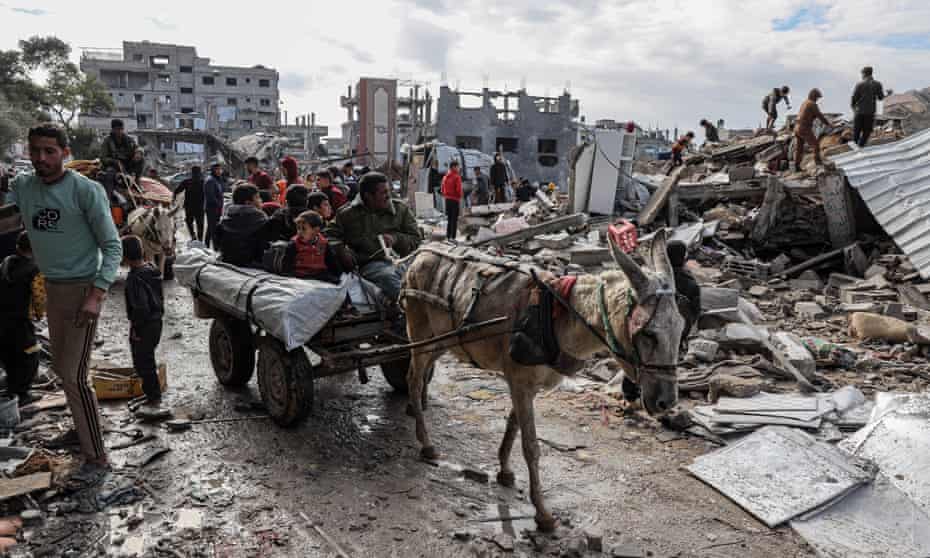
Gaza’s ceasefire was the calm before a brutal storm
In early 2025, a fragile ceasefire between Israel and Hamas in Gaza offered a brief respite from prolonged violence. However, this calm was abruptly shattered as hostilities resumed with unprecedented intensity, leading to a humanitarian crisis and escalating regional tensions.
Ceasefire Breakdown and Immediate Aftermath
The ceasefire, initiated in January 2025, aimed to halt the devastating conflict that had resulted in significant casualties and displacement within Gaza. Despite initial hopes, the truce unraveled in March when Israeli forces launched extensive airstrikes across Gaza, targeting Hamas infrastructure. These strikes resulted in over 200 Palestinian deaths, including women and children, and injured more than 150 others. Notably, civilian shelters such as the Al-Tabi’in School in the Al-Daraj neighborhood and refugee tents in the Mawasi area were among the sites hit.
The Israeli military justified these actions as necessary to dismantle Hamas’s operational capabilities, accusing the group of violating the ceasefire by refusing to release Israeli hostages and rejecting U.S. mediation efforts. Prime Minister Benjamin Netanyahu emphasized that military operations would continue until all hostages were secured and Hamas’s threat neutralized.
Regional Escalation: Hezbollah’s Involvement
The conflict’s scope widened as Hezbollah, operating from Lebanon, launched rocket attacks on the Israeli border town of Metula. In retaliation, Israel conducted airstrikes targeting Hezbollah’s rocket launchers, command centers, and weapons depots. This exchange heightened fears of a broader regional war, with Israeli Defense Minister Israel Katz warning Lebanese officials of severe consequences akin to those faced by Gaza. Hezbollah denied responsibility for the initial attacks but reaffirmed its commitment to the ceasefire, highlighting the fragility of peace in the region.
International Response and U.S. Involvement
The United States responded to the escalating conflict by deploying a second aircraft carrier group, the USS Carl Vinson, to the Middle East, joining the USS Harry S. Truman. This move aimed to bolster U.S. military presence and deter further escalation. President Trump vowed to intensify attacks on groups like the Houthis and hold Iran accountable for any aggression, reflecting the administration’s commitment to supporting Israel and maintaining regional stability.
Domestic Turmoil in Israel
Amid external conflicts, Israel faced internal unrest following Prime Minister Netanyahu’s dismissal of Ronen Bar, the head of the Shin Bet domestic intelligence service. This decision sparked widespread protests in Tel Aviv, with thousands expressing concern over potential threats to democratic institutions. The Supreme Court intervened, temporarily halting Bar’s dismissal. Families of hostages captured by Hamas also participated in the protests, fearing that renewed military actions could jeopardize their loved ones’ safety.
Humanitarian Crisis in Gaza
The resumption of hostilities exacerbated the humanitarian crisis in Gaza. The extensive airstrikes led to massive displacement, with thousands seeking refuge in overcrowded shelters lacking basic necessities. Medical facilities, already strained, struggled to treat the influx of casualties, leading to a dire health emergency. The destruction of infrastructure further hampered aid delivery, intensifying the suffering of the civilian population.
Geopolitical Implications
The conflict’s escalation had significant geopolitical ramifications. Israel’s aggressive military strategy aimed not only at neutralizing immediate threats but also at reshaping the regional power dynamics, particularly concerning Iran’s influence. The U.S. administration’s support for Israel’s actions underscored a broader strategy to counter Iranian-backed groups across the Middle East, signaling a potential shift in the region’s geopolitical landscape.
Prospects for Peace
The abrupt end of the ceasefire and the ensuing violence underscored the complexities of achieving lasting peace in the region. The international community’s calls for restraint and renewed negotiations highlighted the urgent need for a sustainable resolution to the Israeli-Palestinian conflict. However, the deep-seated mistrust between the parties, coupled with external geopolitical interests, continued to pose significant challenges to peace efforts.
The breakdown of the Gaza ceasefire in early 2025 led to a brutal escalation of violence, resulting in substantial loss of life, widespread displacement, and heightened regional tensions. The conflict’s expansion beyond Gaza’s borders, involving actors like Hezbollah and prompting significant international military deployments, highlighted the fragile nature of peace in the Middle East. Addressing the underlying causes of the conflict and fostering genuine dialogue among all stakeholders remain critical to achieving lasting peace and stability in the region.
